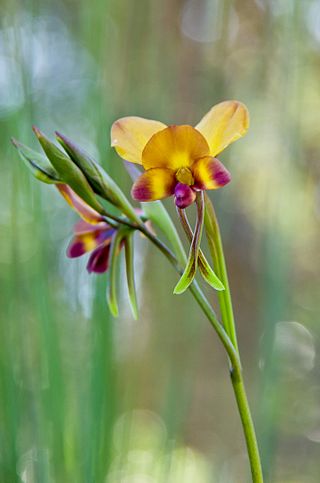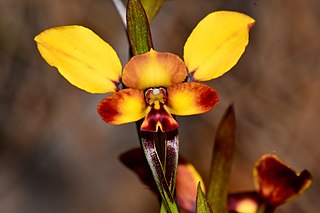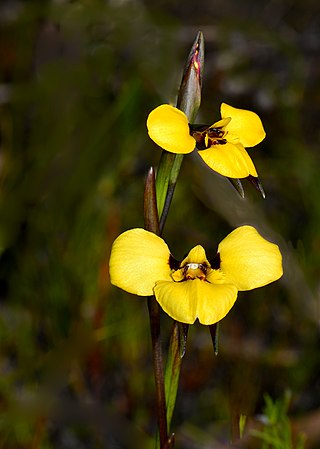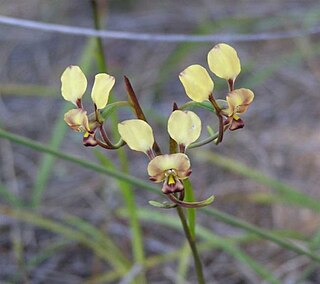
Diuris brumalis, commonly known as the winter donkey orchid, is a species of orchid that is endemic to the south-west of Western Australia. It is one of the first species of donkey orchid to flower in Western Australia each year and its flowers have been shown to attract the same insects that pollinate other species, but without offering a food reward.
Diuris carinata, commonly known as the tall bee orchid, is a species of orchid that is endemic to the south-west of Western Australia. It has between four and six leaves and up to seven large, bright yellow flowers with reddish-brown markings.

Diuris corymbosa, commonly called common donkey orchid or wallflower orchid, is a species of orchid which is endemic to the south-west of Western Australia. It is similar to the purple pansy orchid but its flowers are yellow rather than purple or mauve and it flowers earlier in the year. It also resembles the winter donkey orchid but flowers later than that species. It is one of the most common orchid species in the Perth area, often forms extensive colonies and usually has numerous flowers on the one spike.

Diuris porrifolia, commonly called the small-flowered donkey orchid is a species of orchid which is endemic to the south-west of Western Australia. It has two or three leaves and up to seven yellow flowers with brown or reddish markings. It is similar to the common donkey orchid but its flowers are smaller and it has a more easterly distribution.

Diuris drummondii, commonly known as the tall donkey orchid is a species of orchid which is endemic to the south-west of Western Australia. It is the tallest Diuris and is distinguished from the similar Diuris emarginata by its larger, more widely spaced flowers. The flowers are pale yellow with brown markings.

Diuris filifolia, commonly known as the cat's face orchid, is a species of orchid which is endemic to the south-west of Western Australia. It is one of the rarest Diuris in Western Australia, sometimes flowering in large numbers but only after hot summer fires.

Diuris longifolia, commonly known as purple pansy orchid, is a species of orchid that is endemic to the south-west of Western Australia. It has up to three linear leaves and up to seven purple and mauve flowers with yellowish markings from September to November.

Diuris concinna, commonly called the elegant donkey orchid, is a species of orchid which is endemic to the south-west of Western Australia. It has up to five linear leaves at its base and up to five pale yellow flowers with brown markings. It is found along the south coast, often growing in areas that are flooded in winter and flowering more prolifically after fire the previous summer.
Diuris eburnea, commonly known as Arrowsmith bee orchid, is a species of orchid that is endemic to the south-west of Western Australia. It has between four and six linear leaves and up to eight pale yellow to cream-coloured flowers with reddish markings. It is only known from near the Arrowsmith River north of Eneabba.
Diuris emarginata, commonly called the late donkey orchid, is a species of orchid which is endemic to the south-west of Western Australia. It has up to six leaves and a flowering stem with up to eight yellow flowers with brown markings but only after fires the previous summer.
Diuris heberlei, commonly called Heberle's donkey orchid, is a species of orchid which is endemic to the south-west of Western Australia. It has three to five linear leaves at its base and up to four bright yellow flowers with a reddish brown border around the labellum callus. It is found along the south coast and is one of the last Diuris to flower in Western Australia.
Diuris micrantha, commonly called the dwarf bee orchid or tiny bee orchid, is a rare species of orchid which is endemic to the south-west of Western Australia. It has four to six linear leaves at its base and up to six yellow flowers with reddish brown markings. It grows in swampy places south of Perth.

Diuris picta, commonly called the granite bee orchid or granite donkey orchid, is a species of orchid which is endemic to the south-west of Western Australia. It has between three and five leaves at its base and up to eight creamy-white to yellow flowers with brownish purple markings. It grows on granite outcrops between Menzies and Lake King.

Diuris purdiei, commonly known as Purdie's donkey orchid, is a species of orchid that is endemic to the south-west of Western Australia. It has between five and ten leaves at its base and up to eight pale yellow flowers with reddish-brown or purplish markings. It mainly grows in swampy areas and only flowers after fires the previous summer.

Diuris recurva, commonly called the mini donkey orchid is a species of orchid that is endemic to the south-west of Western Australia. It has one or two leaves at its base, up to six small pale yellow and brownish flowers and grows in winter-wet places between Badgingarra and Kalbarri.

Diuris brockmanii, commonly known as south coast donkey orchid, is a species of orchid that is endemic to the south-west of Western Australia. It has two or three linear leaves and a flowering stem with up to ten yellow flowers with reddish-brown markings.
Diuris insignis, commonly known as dark bee orchid, is a species of orchid that is endemic to the south-west of Western Australia. It has between two and six narrowly linear to thread-like leaves and up to five yellow flowers with many dark red markings.
Diuris segregata, commonly known as Northampton bee orchid, is a species of orchid that is endemic to the south-west of Western Australia. It has between two and six narrowly linear to thread-like leaves and up to three yellow flowers, usually with dark red markings.

Diuris septentrionalis, commonly known as northern bee orchid, is a species of orchid that is endemic to the south-west of Western Australia. It has two or three linear leaves and up to five yellow flowers with dark red markings.
Diuris tinctoria, commonly known as sandplain donkey orchid, is a species of orchid that is endemic to the south-west of Western Australia. It has two or three linear to lance-shaped leaves and two to five pale yellow flowers suffused with light brown.












